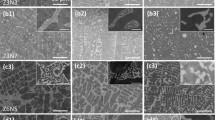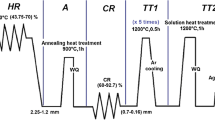Abstract
Understanding the thermal stability of intermetallic phases in Fe-rich Fe-Cr-Ni-Mo alloys is critical to alloy design and application of Mo-containing austenitic steels. Coupled with thermodynamic modeling, the thermal stability of intermetallic Chi and Laves phases in two Fe-Cr-Ni-Mo alloys was investigated at 1273 K, 1123 K, and 973 K (1000 °C, 850 °C, and 700 °C) for different annealing times. The morphologies, compositions, and crystal structures of the precipitates of the intermetallic phases were carefully examined by scanning electron microscopy, electron probe microanalysis, X-ray diffraction, and transmission electron microscopy. Two key findings resulted from this study. First, the Chi phase is stable at high temperature, and with the decreasing temperature it transforms into the Laves phase that is stable at low temperature. Secondly, Cr, Mo, and Ni are soluble in both the Chi and Laves phases, with the solubility of Mo playing a major role in the relative stability of the intermetallic phases. The thermodynamic models that were developed were then applied to evaluating the effect of Mo on the thermal stability of intermetallic phases in type 316 and NF709 stainless steels.








Similar content being viewed by others
References
S. J. Zinkle and J. T. Busby, Materials Today, 2009, vol. 12, pp.12–19.
B. Weiss and R. Stickler, MT, 1972, vol. 3, pp.851–66.
T. Sourmail, Materials Science and Technology, 2001, vol. 17, pp.1–14.
Y. Yamamoto, M. Takeyama, Z. P. Lu, C. T. Liu, N. D. Evans, P. J. Maziasz and M. P. Brady, Intermetallics, 2008, vol. 16, pp.453–62.
T.-H. Lee, C.-S. Oh, C. G. Lee, S.-J. Kim and S. Takaki, Scripta materialia, 2004, vol. 50, pp.1325–28.
A. Perron, C. Toffolon-Masclet, X. Ledoux, F. Buy, T. Guilbert, S. Urvoy, S. Bosonnet, B. Marini, F. Cortial and G. Texier, Acta Materialia, 2014, vol. 79, pp.16–29.
M. Schwind, J. Källqvist, J.-O. Nilsson, J. Ågren and H.-O. Andrén, Acta Materialia, 2000, vol. 48, pp.2473–81.
J.-O. Andersson and N. Lange, MTA, 1988, vol. 19, pp.1385–94.
K. Frisk, MTA, 1992, vol. 23, pp.639–49.
B.-J. Lee, Journal of the Korean Institute of Metals and Materials, 1993, vol. 31, pp.480–89.
S. Liu, Y. Hamaguchi and H. Kuwano, J. Jpn. Inst. Met., 1986, vol. 50, pp.1023–31.
H.L. Lukas: Chromium-Molybdenum-Nickel. Refractory Metal Systems. Springer, Berlin, 2010, p. 170–81.
G. Raynor and V. Rivlin, Bull. Alloy Phase Diagrams, 1981, vol. 2, pp.89–99.
N. Saunders and A. P. Miodownik: CALPHAD (Calculation of Phase Diagrams): A Comprehensive Guide: A Comprehensive Guide. Elsevier, 1998.
Y. A. Chang, S. Chen, F. Zhang, X. Yan, F. Xie, R. Schmid-Fetzer and W. A. Oates, Progress in Materials Science, 2004, vol. 49, pp.313–45.
Y. Yang, H. Bei, S. Chen, E. George, J. Tiley and Y. A. Chang, Acta Materialia, 2010, vol. 58, pp.541–48.
Y. Yang and J. Busby, Journal of Nuclear Materials, 2014, vol. 448, pp.282–93.
M. Hillert, Journal of Alloys and Compounds, 2001, vol. 320, pp.161–76.
A. T. Dinsdale, CALPHAD, 1991, vol. 15, pp.317–425.
O. Redlich and A. T. Kister, Industrial & Engineering Chemistry, 1948, vol. 40, pp.345–48.
M. Hillert and M. Jarl, CALPHAD, 1978, vol. 2, pp.227–38.
G. Inden: Proceedings Project Meeting, CALPHAD V, Dusseldorf, 1976. pp. 1–13.
J.-M. Joubert, Progress in Materials Science, 2008, vol. 53, pp.528–83.
J. Kasper, Acta Metallurgica, 1954, vol. 2, pp.456–61.
J.-M. Joubert and M. Phejar, Progress in Materials Science, 2009, vol. 54, pp.945–80.
W. Cao, S.-L. Chen, F. Zhang, K. Wu, Y. Yang, Y. Chang, R. Schmid-Fetzer and W. Oates, CALPHAD, 2009, vol. 33, pp.328–42.
A. Denham. Silcock, J IRON STEEL INST, 1969, vol. 207, pp.582–92.
Acknowledgments
This research was supported by the U.S. Department of Energy (DOE), Office of Nuclear Energy, Nuclear Engineering Enabling Technology (NEET) Advanced Reactor Material Program and Light Water Reactor Sustainability Research and Development Effort, under contract DE-AC05-00OR22725 with UT-Battelle, LLC.
Author information
Authors and Affiliations
Corresponding author
Additional information
Manuscript submitted December 11, 2014.
Appendix
Appendix
Optimized thermodynamic model parameters for the Chi and Laves phases in the Fe-Cr-Mo-Ni system. (Other model parameters are available from literature[17]). The temperature range of the parameters is between 298.15 K and 6000 K (25 °C and 5727 °C) unless otherwise denoted. Unit is J/(mol. formula). \( G_{Fe}^{fcc,0} \), \( G_{Ni}^{fcc,0} \), and \( G_{Mo}^{bcc,0} \) are taken from the SGTE pure element database.[19]
Chi: (Cr,Fe,Ni)24(Cr,Mo)10(Cr,Fe,Ni)24
Laves: (Cr,Fe,Ni)2(Cr,Fe,Mo,Ni)
Rights and permissions
About this article
Cite this article
Yang, Y., Tan, L. & Busby, J.T. Thermal Stability of Intermetallic Phases in Fe-rich Fe-Cr-Ni-Mo Alloys. Metall Mater Trans A 46, 3900–3908 (2015). https://doi.org/10.1007/s11661-015-2997-y
Published:
Issue Date:
DOI: https://doi.org/10.1007/s11661-015-2997-y




